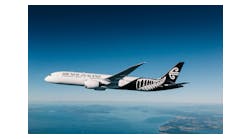Oct. 08--The first-ever sale of Airbus jets to Japan Airlines has not only cost Boeing an important potential customer for its forthcoming 777X jet, it has jeopardized the company's tight relationship with the major Japanese manufacturing partners that built ever-increasing portions of Boeing's previous jets.
Monday's order by Japan Airlines (JAL) for 31 Airbus A350 aircraft is a heavy blow in the battle for widebody-jet sales that had previously seemed tilted toward Boeing.
It also represents a fissure in the interlocking arrangement that previously brought the Japanese government, major airlines and the Japanese heavy-industrial companies all together in supporting Boeing.
The Airbus win "does more than damage Boeing's market standing," said Richard Aboulafia, industry analyst with the Teal Group. "It damages the terms they'll get when they talk to Japan about an industrial role."
Boeing has derived considerable financial benefit, most recently on the 787 Dreamliner program, from Japanese government subsidies to parts manufacturers Mitsubishi, Fuji and Kawasaki, the three "heavies."
The Japanese carriers then became launch customers, sealing the jet's business success.
"This order will undercut the business case for the Japanese heavies. That's the real damage," Aboulafia said. "These are the biggest jet subcontractors on the planet. They are the biggest investors."
Scott Hamilton, aviation analyst with Leeham.net, cited recent speculation on an aviation blog that Mitsubishi might get to build the giant plastic composite wing for 777X in exchange for orders for the jet from JAL and its Japanese rival ANA.
Mitsubishi "can probably kiss that goodbye," said Hamilton.
A person familiar with the thinking of Japanese aviation executives, who asked not to be identified, said that because the Airbus planes, unlike Boeing's, contain few parts built in Japan, "the Japanese aviation industry will not welcome this result."
JAL's order of 31 A350s is precisely enough to replace all of JAL's current long-range 777s. That may close off the option of a later order for 777Xs.
So while JAL will likely stick with Boeing 787s for its midsize twin-aisle fleet, its needs for bigger aircraft that have 300-plus seats may now be covered by Airbus.
Given the traffic density on some of the Japanese routes, Airbus sales chief John Leahy will now hope to follow up by persuading JAL to order his superjumbo A380.
The JAL defection follows a big win for Boeing last month when German flag carrier Lufthansa, the only major global carrier that had never ordered 777 passenger planes, committed to buy 34 Boeing 777-9Xs.
However, in that case, it was a split order. Lufthansa also ordered 25 Airbus A350-900s at the same time.
In JAL's case, it was winner take all.
The A350 order is worth $9.5 billion at list prices, The Associated Press reported, although discounts are common.
Aboulafia said he still strongly believes Boeing's offerings in the large widebody category -- the 787 and 777X families -- are clearly superior to Airbus' single family of A350s .
He sees the JAL order as a terrible missed opportunity, caused by Boeing leadership's stop-and-go approach to launching the 777X, which has been talked about for a couple of years and is now expected to formally launch next month.
"787 and 777X should have won Boeing unquestioned dominance of all the key customers," Aboulafia said. "The problem is the management of Boeing. They have been incredibly passive about getting this program launched."
Airbus previously won two key A350 orders from Cathay Pacific and IAG, parent company of British Airways and Iberia. Both were significant losses for Boeing.
"How many times do you hit the snooze button on the alarm?" Aboulafia said of Boeing's management.
JAL's decision to go with Airbus means it is rejecting its former dependence on a single airplane manufacturer.
Aside from some smaller regional jets, JAL's current fleet is all-Boeing, consisting of more than 60 single-aisle 737s and more than 160 twin-aisle 767s, 777s, and 787s.
Shortly after the 787s were grounded due to problems with overheating batteries, the airline's reliance on Boeing as a sole supplier was decried as "abnormal" by its former chairman, Kazuo Inamori.
Inamori is a revered business leader who had founded Japanese electronics company Kyocera and was brought in by the Japanese government to rescue JAL from bankruptcy, which he accomplished 18 months ago.
"In a normal market there is tremendous risk from relying on one vendor," Inamori said in a February interview with CNBC. He added that to encourage competitive pricing and quality, "a dual vendor system is a must."
Inamori, who transformed the airline's thinking about costs and turned it around financially in just three years, retired at the age of 81 in March.
The airline's first-ever Airbus order appears to be part of his legacy.
Another part of the reason for the defection may be JAL's frustration with the 787 Dreamliner's in-service problems.
JAL operated the Dreamliner that caught fire on the ground in Boston in early January, prompting the worldwide grounding of the fleet.
The airline resumed 787 flights in June, but since then has cataloged multiple reliability issues.
JAL maintains a tally of technical incidents with the 787. Since June, five JAL Dreamliners turned back while in the air, nine were forced to return to the gate before takeoff due to technical issues, and in two cases other aircraft had to be substituted at the last minute.
Technical problems on six other Dreamliners resulted in delays of more than two hours.
Analyst Hamilton said that litany of reliability issues may have weighed more heavily against Boeing in JAL's boardroom than the grounding due to the batteries.
It's possible that JAL executives decided, having suffered through these early Dreamliner glitches, that next time it didn't want to be a launch customer for a new jet.
In February, Inamori said JAL should have been more wary of all the new technology on the jet.
"We should have been much, much more careful," Inamori told CNBC. "It is unacceptable to jump at every new technological breakthrough."
The A350-900 is due to enter service in 2015, and JAL won't get its first one until 2019, providing time to iron out any wrinkles in the systems.
The 777X is due to enter service as a new airplane in 2019 or 2020.
Meanwhile, ANA is weighing an order for about 25 long-haul jets, choosing between the 777X and the A350.
And both Boeing and its Japanese partners will keep moving forward with 777X despite Monday's embarrassing loss. The Japan Aircraft Development Corp.(JADC), a consortium of the major Japanese aerospace companies, is researching "innovative technologies with Boeing to ... provide more efficient performance for 777-X," according to the JADC website.
And in Dubai, next month, Emirates is expected to launch the 777X with an order that Hamilton says should be at least 50 jets, possibly twice that.
Few thought Airbus could swing the sales momentum its way in Japan. To counter that, Boeing will try to deliver a big show in Dubai to get its own momentum going.
Dominic Gates: (206) 464-2963 or [email protected]
Copyright 2013 - The Seattle Times




